Oldsmobile Achieva 1995 Owner's Manuals
Manufacturer: OLDSMOBILE, Model Year: 1995, Model line: Achieva, Model: Oldsmobile Achieva 1995Pages: 340, PDF Size: 16.99 MB
Page 251 of 340
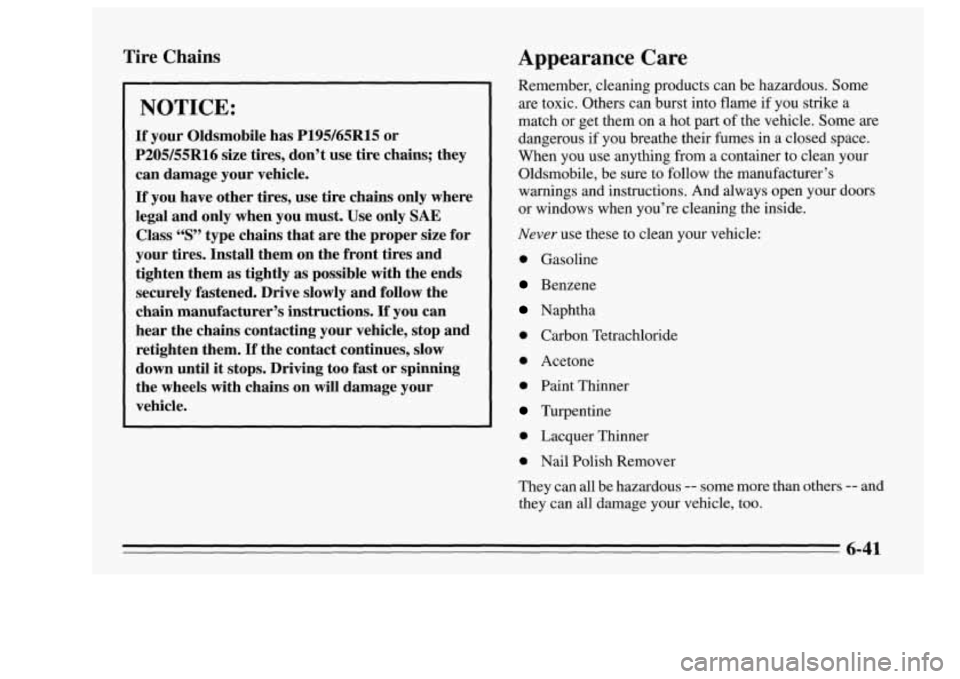
Tire Chains
NOTICE:
If your Oldsmobile has P195/65R15 or
P205/55R16 size tires, don’t use tire chains; they
can damage your vehicle.
If you have other tires, use tire chains only where
legal and only when you must. Use only
SAE
Class “S” type chains that are the proper size for
your tires. Install them on the front tires and
tighten them
as tightly as possible with the ends
securely fastened. Drive slowly and follow the
chain manufacturer’s instructions. If you can
hear the chains contacting your vehicle, stop and
retighten them.
If the contact continues, slow
down until
it stops. Driving too fast or spinning
the wheels with chains on will damage your
vehicle.
Appearance Care
Remember, cleaning products can be hazardous. Some are toxic. Others can burst into flame if you strike a
match or get them on a hot
part of the vehicle. Some are
dangerous if you breathe their fumes in a closed space.
When you use anything from a container to clean your
Oldsmobile, be sure to follow the manufacturer’s warnings and instructions. And always open your doors
or windows when you’re cleaning the inside.
Never use these to clean your vehicle:
0 Gasoline
Benzene
Naphtha
0 Carbon Tetrachloride
0 Acetone
0 Paint Thinner
Turpentine
0 Lacquer Thinner
0 Nail Polish Remover
They can
all be hazardous -- some more than others -- and
they can all damage your vehicle, too.
6-41
-
Page 252 of 340
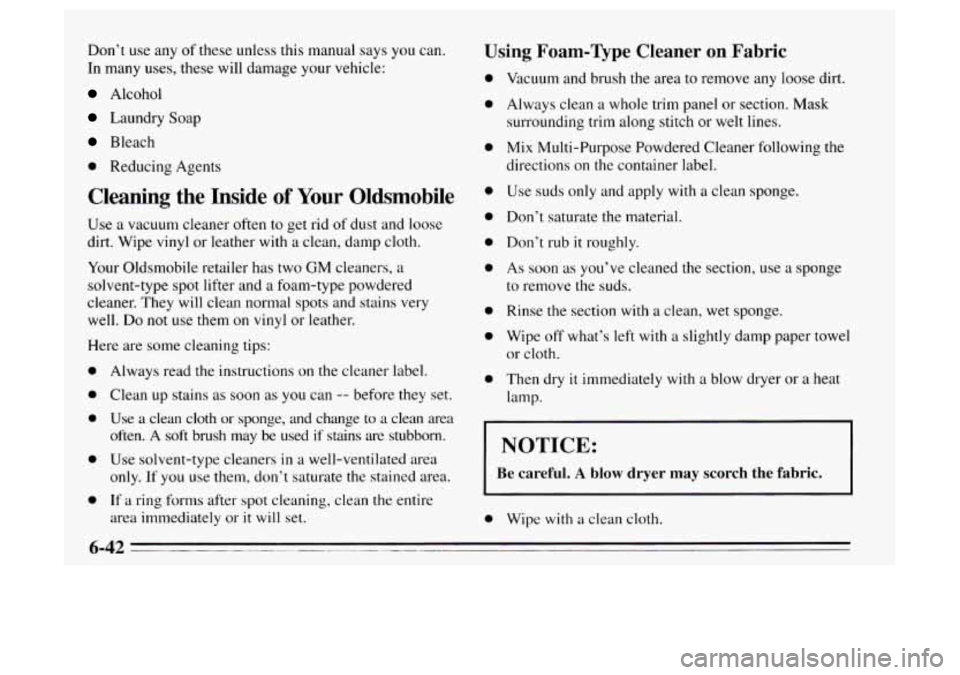
Don’t use any of these unless this manual says you can.
In many uses, these will damage your vehicle:
Alcohol
Laundry Soap
Bleach
0 Reducing Agents
Cleaning the Inside of Your Oldsmobile
Use a vacuum cleaner often to get rid of dust and loose
dirt. Wipe
vinyl or leather with a clean, damp cloth.
Your Oldsmobile retailer has two
GM cleaners, a
solvent-type spot lifter and a foam-type powdered
cleaner. They will clean normal spots and stains very
well. Do
not use them on vinyl or leather.
Here are some cleaning tips:
0 Always read the instructions on the cleaner label.
0 Clean up stains as soon as you can -- before they set.
0 Use a clean cloth or sponge, and change to a clean area
0 Use solvent-type cleaners in a well-ventilated area
0 If a ring forms after spot cleaning, clean the entire
often.
A soft brush may be used
if stains are stubborn.
only. If you use them, don’t saturate the stained area.
area immediately or
it will set.
Using Foam-Type Cleaner on Fabric
0
0
0
0
0
0
0
0
0
0
Vacuum and brush the area to remove any loose dirt.
Always clean
a whole trim panel or section. Mask
surrounding trim along stitch or welt lines.
Mix Multi-Purpose Powdered Cleaner following
the
directions on the container label.
Use suds only and apply with a clean sponge.
Don’t saturate the material.
Don’t rub it roughly.
As soon as you’ve cleanea me section, use a sponge
to remove the suds.
Rinse the section with a clean, wet sponge.
Wipe off what’s left with a slightly damp paper towel
OS cloth.
Then dry
it immediately with a blow dryer or a heat
lamp.
NOTICE:
Be careful. A blow dryer may scorch the fabric.
0 Wipe with a clean cloth.
Page 253 of 340
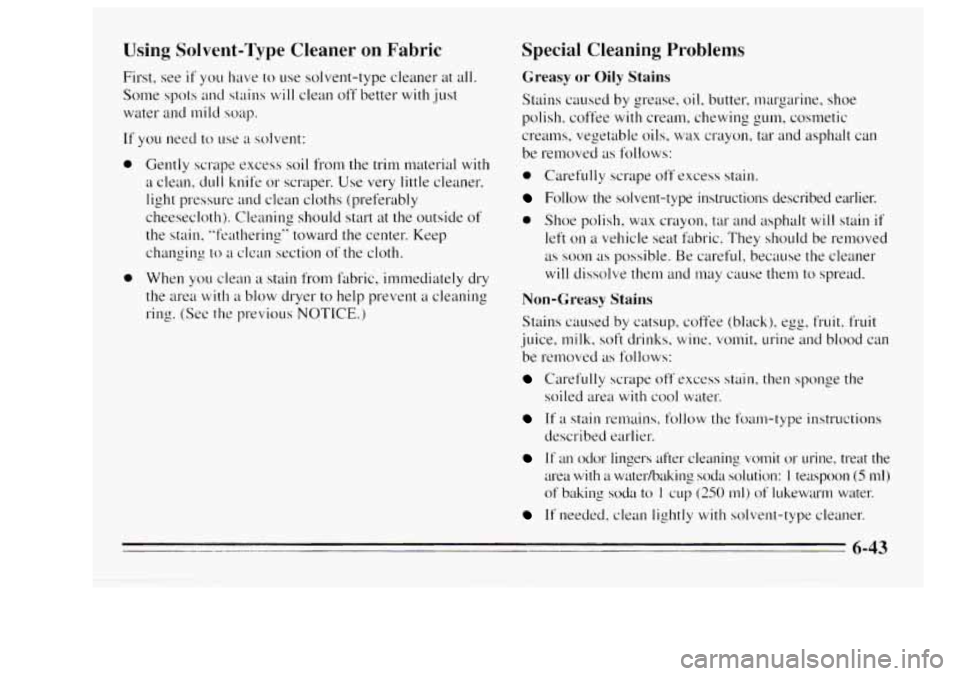
Using Solvent-Type Cleaner on Fabric
First, see if you have to use solvent-type cleaner at all.
Some
spots and stains will clean off better with just
water
and mild soap.
If you need to LIS~ a solvent:
0 Gently scrape excess soil from the trim material with
a clean, dull knife or scraper. Use very little cleaner,
light pressure
and clean cloths (preferably
cheesecloth). Cleaning should start
at the outside of
the stain, "feathering" toward the center. Keep
changing
to a clean section of the cloth.
0 When you clean a stain from fabric, immediately dry
the area
with a blow dryer to help prevent a cleaning
ring. (See the previous
NOTICE.)
Special Cleaning Problems
Greasy or Oily Stains
Stains caused by grease, oil, butter, margarine, shoe
polish, coffee
with cream, chewing ~LIIII, cometic
creams. vegetable
oils, wax crayon, tar and asphalt can
be removed
as follows:
0 Carefully scrape off excess stain.
Follow the solvent-type instructions described earlier.
0 Shoe polish, wax crayon, tar and asphalt will stain if
left on a vehicle seat fabric. They should be removed
as soon as possible. Be careful. because the cleaner
will dissolve them and may cause them to spread.
Non-Greasy Stains
Stains caused by catsup, coffee (black), egg, fruit, fruit
juice, milk, soft drinks, wine. vomit. urine and blood can
be removed
as follows:
Caref~111y scrape off excess stain, then sponge the
soiled area
with cool water.
If a stain remains, follow the foam-type instructions
described earlier.
If an odor lingers after cleaning vomit or urine, treat the
area
with a waterhaking soda sol~~tion: 1 teaspoon (5 ml)
of baking soda to 1 CLIP (250 1111) of lukewarm water.
If needed, clean lightly with solvel~t-type cleaner.
6-43
Page 254 of 340
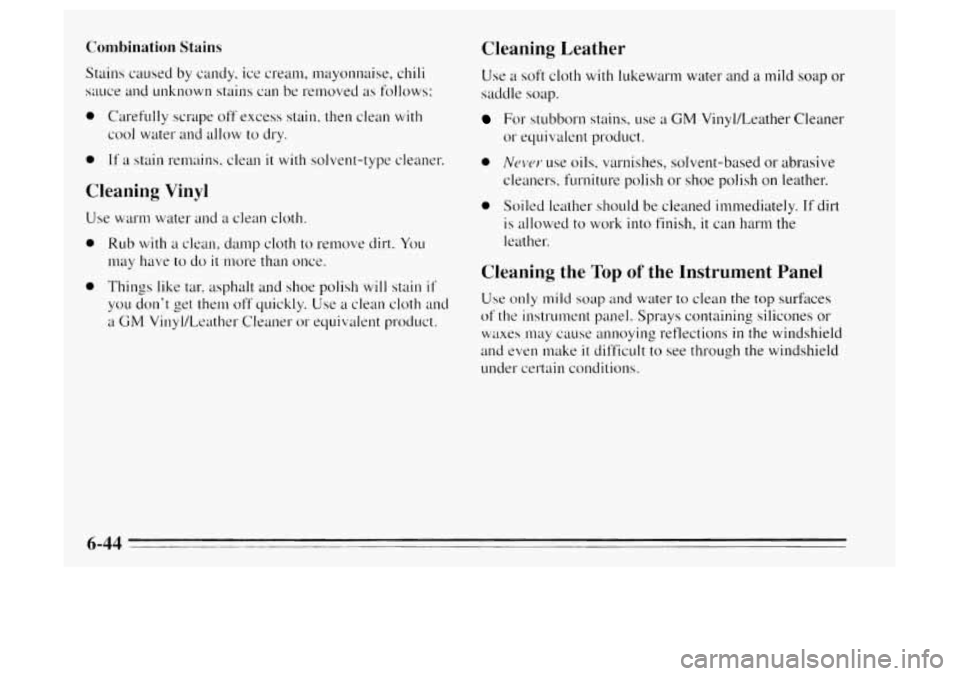
Combination Stains
Stains caused by candy, ice cream, mayonnaise, chili
sauce and unknown stains can be removed as follows:
0 Carefully scrape off excess stain, then clean with
cool water and allow to dry.
0 If a stain remains, clean it with solvent-type cleaner.
Cleaning Vinyl
Use warm water and a clean cloth.
0 Rub with a clean, damp cloth to remove dirt. You
may have to do it more than once.
0 Things like tar, asphalt and shoe polish will stain if
you doll’t get them off quickly. Use a clean cloth and
a GM Vinyl/Leather Cleaner or equivalent product.
Cleaning Leather
Use a soft cloth with lukewarm water and a mild soap or
saddle soap.
For stubborn stains, use a GM VinyVLeather Cleaner
or equivalent product.
0 Ncwr use oils, varnishes, solvent-based or abrasive
cleaners. furniture polish or shoe polish on leather.
0 Soiled leather should be cleaned immediately. If dirt
is allowed to work into finish,
it can harm the
leather.
Cleaning the Top of the Instrument Panel
Use only mild soap and water to clean the top surfaces
of the instrunlent panel. Sprays containing silicones or
waxes
may cause annoying reflections in the windshield
and even mike
it difficult to see through the windshield
under certain conditions.
6-44
Page 255 of 340
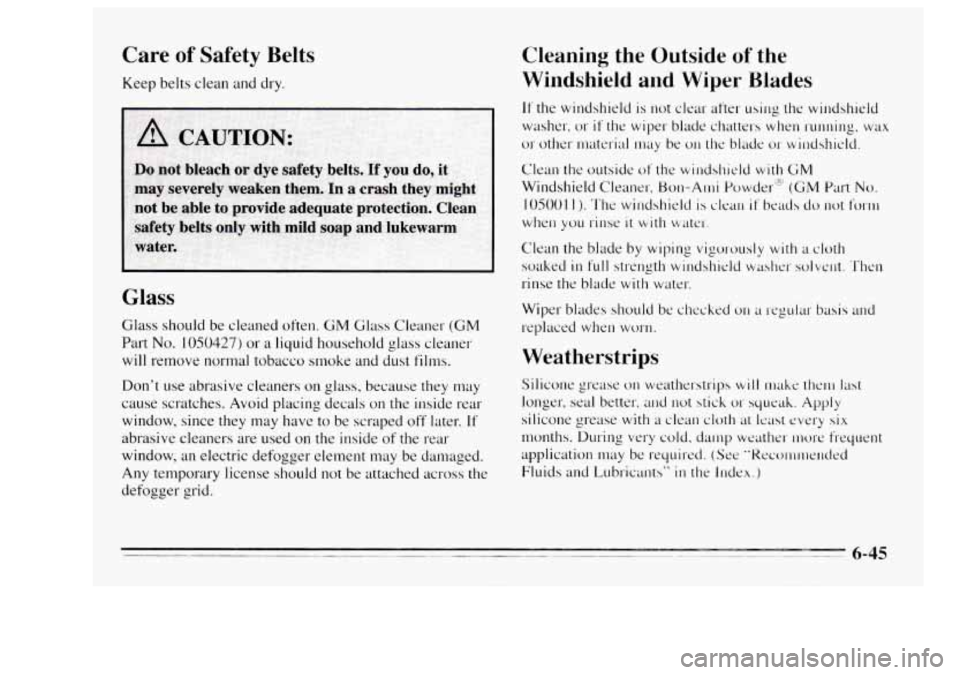
Care of Safety Belts
Keep belts clean and dry.
Glass
Glass should be cleaned often. GM Glass Cleaner (GM
Part No. 1050427) or a liquid household glass cleaner
will remove normal tobacco smoke and dust films.
Don't use abrasive cleaners on glass, because they may
cause scratches. Avoid placing decals
on the inside rear
window, since they may have to be scraped off later.
If
abrasive cleaners are used on the inside of the rear
window, an electric defogger element may be damaged.
Any temporary license should not be attached across the
defogger grid.
Cleaning the Outside of the
Windshield and Wiper
Blades
If the windshield is not clear after using the windshield
washer,
or if the wiper- blade chatters when running, wax
or- other nuterial may be 011 the blade 01- windshield.
Clean the outside
of the windshield with GM
Windshield Cleaner, Bon-Ami Powder"." (GM Part No.
105001 1). 'The wir~dshield is clean if beads do not for111
when yo~t rinse it with watel.
Clean the blade
by wiping vigorously with a cloth
soaked
in full strength windshield washer solvent. 'rhen
rinse the blade with water.
Wiper blades should be checked
011 a regular basis and
replaced when worn.
Weatherstrips
Silicone grease on weatherstrips will tnake the111 last
longer, seal better,
and not stick 01' squeak. Apply
silicone grease
with a clean cloth at Ica~t ever-y six
months. During very cold,
darnp weather 11w-e frequent
application
may be required. (See "Kttco~nnletlded
Fluids
and Lubricants" in the I~ldex.)
Page 256 of 340
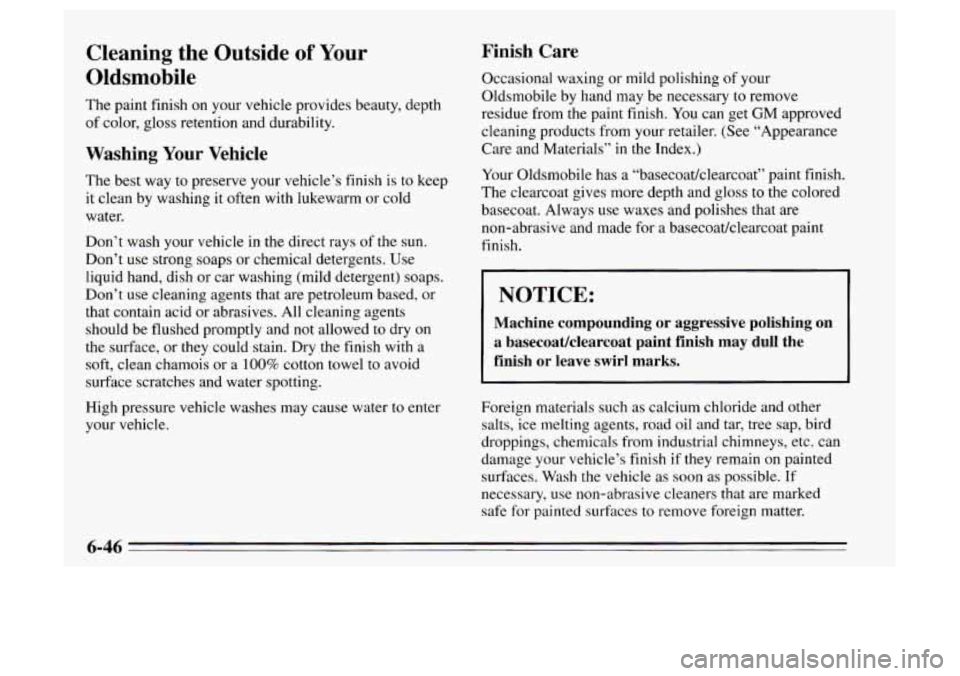
Cleaning the Outside of Your
Oldsmobile
The paint finish on your vehicle provides beauty, depth
of color, gloss retention and durability.
Washing Your Vehicle
The best way to preserve your vehicle’s finish is to keep
it clean by washing it often with lukewarm or cold
water.
Don’t wash your vehicle in the direct rays of the sun.
Don’t use strong soaps or chemical detergents. Use
liquid hand, dish or car washing (mild detergent) soaps.
Don’t use cleaning agents that are petroleum based, or
that contain acid or abrasives. All cleaning agents
should be flushed promptly and
not allowed to dry on
the surface, or they could stain. Dry the finish with
a
soft, clean chamois or a 100% cotton towel to avoid
surface scratches and water spotting.
High pressure vehicle washes may cause water to enter
your vehicle.
Finish Care
Occasional waxing or mild polishing of your
Oldsmobile
by hand may be necessary to remove
residue from the paint finish. You can get
GM approved
cleaning products from your retailer. (See “Appearance
Care and Materials”
in the Index.)
Your Oldsmobile
has a “basecoatlclearcoat” paint finish.
The clearcoat gives more depth and gloss to the colored
basecoat. Always use waxes and polishes that are
non-abrasive and made for
a basecoatklearcoat paint
finish.
I NOTICE:
Machine compounding or aggressive polishing on
a basecoat/clearcoat paint finish may dull the
finish
or leave swirl marks.
Foreign materials such as calcium chloride and other salts, ice melting agents, road oil and tar, tree sap, bird
droppings, chemicals from industrial chimneys, etc. can
damage your vehicle’s finish if they remain on painted
surfaces. Wash the vehicle as
soon as possible. If
necessary,
use non-abrasive cleaners that are marked
safe
for painted surfaces to remove foreign matter.
6-46
Page 257 of 340
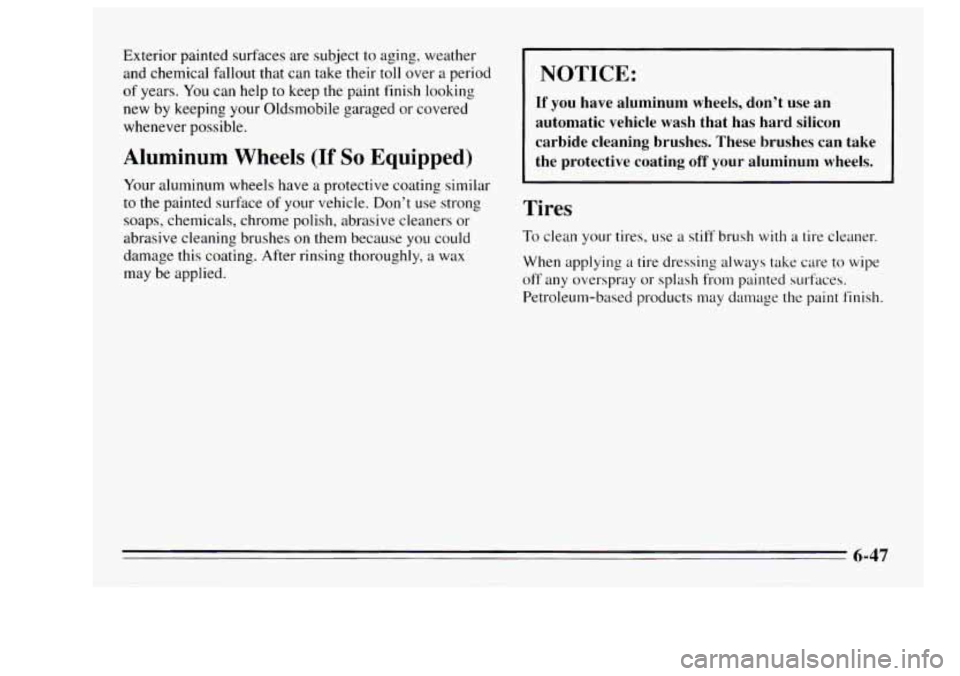
Exterior painted surfaces are subject to aging, wexner
and chemical fallout that can take their toll over a period
of years. You can help to keep the paint finish looking
new by keeping your Oldsmobile garaged or covered
whenever possible.
Aluminum Wheels (If So Equipped)
Your aluminum wheels have a protective coating similar
to
the painted surface of your vehicle. Don’t use strong
soaps, chemicals, chrome polish, abrasive cleaners or
abrasive cleaning brushes
on them because you could
damage this coating. After rinsing thoroughly, a wax
may be applied.
NOTICE:
If you have aluminum wheels, don’t use an
automatic vehicle wash that has hard silicon
carbide cleaning brushes. These brushes can take
the protective coating
off your aluminum wheels.
Tires
To clean your tires, use a stiff brush with a tire cleaner.
When applying a tire dressing always take care to wipe
off any overspray or splash from painted surfxes.
Petroleum-based products may danlage the paint finish.
6-47
Page 258 of 340
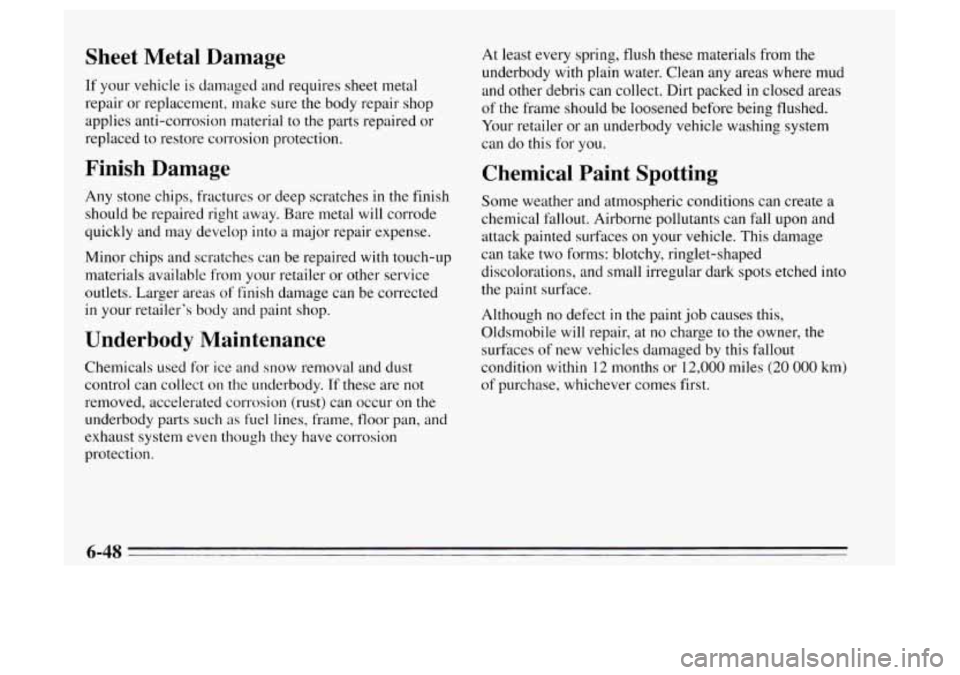
Sheet Metal Damage
If your vehicle is damaged and requires sheet metal
repair or replacement, make sure the body repair shop
applies anti-corrosion material to
the parts repaired or
replaced to restore corrosion protection.
Finish Damage
Any stone chips, fractures or deep scratches in the finish
should be repaired right away. Bare metal will corrode
quickly and may develop into a major repair expense.
Minor chips and scratches can be repaired with touch-up
materials available from your retailer or other service
outlets. Larger areas of
finish damage can be corrected
in your retailer’s body
and paint shop.
Underbody Maintenance
Chemicals used for ice and snow removal and dust
control can collect
on the underbody. If these are not
removed, accelerated corrosion (rust) can occur on
the
underbody parts such as fuel lines, frame, floor pan, and
exhaust system even though they have corrosion
protection.
At least every spring, flush these materials from the
underbody with plain water. Clean any areas where mud
and other debris can collect. Dirt packed in closed areas
of the frame should be loosened before being flushed.
Your retailer or an underbody vehicle washing system
can do this for you.
Chemical Paint Spotting
Some weather and atmospheric conditions can create a
chemical fallout. Airborne pollutants can fall upon and
attack painted surfaces on your vehicle. This damage
can take two forms: blotchy, ringlet-shaped
discolorations, and small irregular dark spots etched into
the paint surface.
Although no defect
in the paint job causes this,
Oldsmobile will repair, at no charge
to the owner, the
surfaces of new vehicles damaged by this fallout
condition within
12 months or 12,000 miles (20 000 km)
of purchase, whichever comes first.
6-48
Page 259 of 340
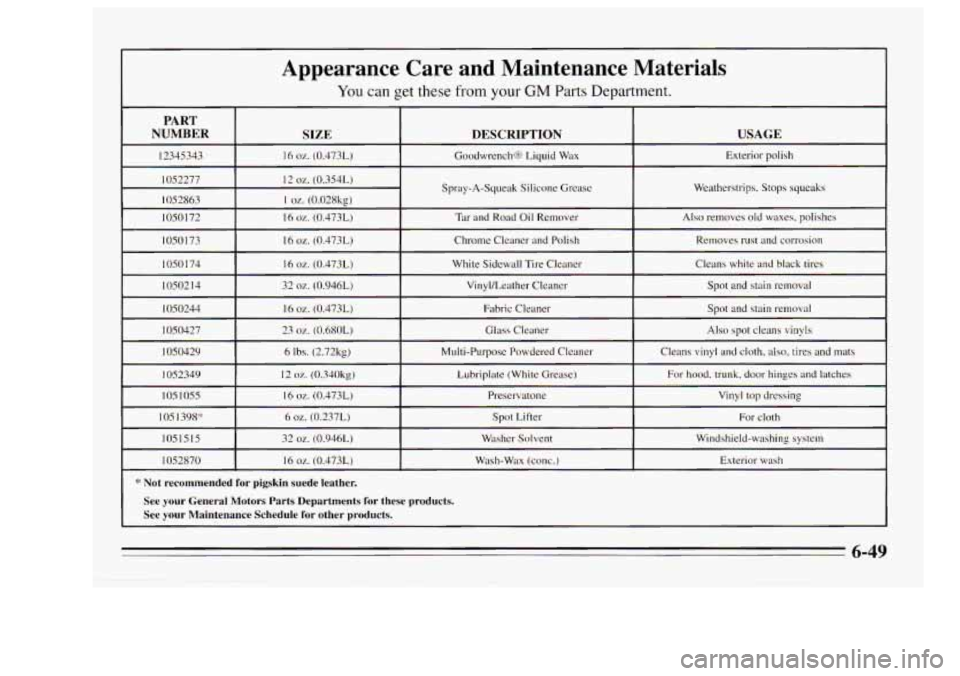
I 1
Appearance Care and Maintenance Materials
You can get these from your GM Parts Department.
Spray-A-Squeak Silicone Grease
I * Not recommended for pigskin suede leather. I
See your General Motors Parts Departments for these products.
See your Maintenance Schedule for other products.
Page 260 of 340

Vehicle Identification Number (VIN)
b!l SAMPLE4UXSM072675
ENGINE / 1&5 IfSElBLY
CODE MODEL YEAR
This is the legal identifier for your Oldsmobile. It
appears on a plate in the front corner
of the instrument
panel, on the driver’s side.
You can see it if you look
through
the windshield from outside your vehicle. The
VIN also appears on the Vehicle Certification and
Service Parts labels and the certificates of title and
registration.
Engine Identification
The eighth character in your VIN is the engine code.
This code will help you identify your engine,
specifications, and replacement parts.
Service Parts Identification Label
You’ll find this label on the bottom of your spare tire
cover. It’s very helpful if you ever need to order parts.
On this label is:
your VIN,
0 the model designation,
paint information, and
0 a list of all production options and special equipment.
Be sure that this label is not removed from the vehicle.
Add-on Electrical Equipment
1 NOTICE:
Don’t add anything electrical to your Oldsmobile
unless you check with your retailer
fmt. Some
electrical equipment can damage your vehicle and
the damage wouldn’t be covered by your warranty.
Some add-on electrical equipment can keep other
components from working
as they should.
Your vehicle has an air bag system. Before attempting to
add anything electrical
to your Oldsmobile, see “Servicing
Your Air Bag-Equipped Oldsmobile” in the Index.
6-50
-